Rank
|
Emblem
|
Requirements
|
Scout
|
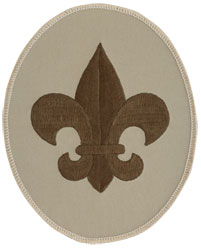
|
Scout/Joining Requirements:
- Meet the age requirements. Be a scout who is 11 years old, or one who has completed the fifth grade or earned the Arrow of Light Award and is at least 10 years old, but is not yet 18 years old.
- Find a Scout troop near your home.
- Complete a Scouts BSA application and health history signed by your parent or guardian.
- Repeat the Pledge of Allegiance.
- Demonstrate the Scout sign, salute, and handshake.
- Demonstrate tying the square knot (a joining knot).
- Understand and agree to live by the Scout Oath or Promise, Law, motto, and slogan, and the Outdoor Code.
- Describe the Scout badge.
- Complete the pamphlet exercises. With your parent or guardian, complete the exercises in the pamphlet How to Protect Your Children From Child Abuse: A Parent’s Guide.
- Participate in a Scoutmaster conference. Turn in your Scouts BSA application and health history form signed by your parent or guardian, then participate in a Scoutmaster conference
|
Tenderfoot
|
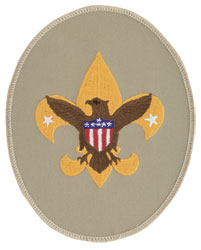
|
Tenderfoot Requirements:
- Present yourself to your leader, properly dressed, before going on an overnight camping trip. Show the camping gear you will use. Show the right way to pack and carry it.
- Spend at least one night on a patrol or troop campout. Sleep in a tent you have helped pitch.
- On the campout, assist in preparing and cooking one of your patrol’s meals. Tell why it is important for each patrol member to share in meal preparation and cleanup, and explain the importance of eating together.
- Demonstrate
- 4a. Demonstrate how to whip and fuse the ends of a rope.
- 4b. Demonstrate that you know how to tie the following knots and tell what their uses are: two half hitches and the taut-line hitch.
- 4c. Using the EDGE method, teach another person how to tie the square knot.
- Explain the rules of safe hiking, both on the highway and cross- country, during the day and at night. Explain what to do if you are lost.
- Demonstrate how to display, raise, lower, and fold the American flag.
- Repeat from memory and explain in your own words the Scout Oath, Law, motto, and slogan.
- Know your patrol name, give the patrol yell, and describe your patrol flag.
- Explain the importance of the buddy system as it relates to your personal safety on outings and in your neighborhood. Describe what a bully is and how you should respond to one.
- 10a. Record your best in the following tests:
Current results: Push-ups ________ Pull-ups ________ Sit-ups ________ Standing long jump (______ ft. ______ in.) 1⁄4-mile walk/run _____________
30 days later: Push-ups ________ Pull-ups ________ Sit-ups ________ Standing long jump (______ ft. ______ in.) 1⁄4-mile walk/run _____________
10b. Show improvement in the activities listed in requirement 10a after practicing for 30 days.
- Identify local poisonous plants; tell how to treat for exposure to them.
- 12a. Demonstrate how to care for someone who is choking.
12b. Show first aid for the following:
- Simple cuts and scrapes
- Blisters on the hand and foot
- Minor (thermal/heat) burns or scalds (superficial, or first-degree)
- Bites or stings of insects and ticks
- Venomous snakebite
- Nosebleed
- Frostbite and sunburn
- Demonstrate Scout spirit by living the Scout Oath (Promise) and Scout Law in your everyday life. Discuss four specific examples of how you have lived the points of the Scout Law in your daily life.
- Participate in a Scoutmaster conference.
- Complete your board of review.
|
Second Class
|
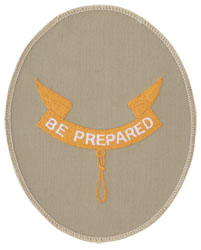
|
Second Class Requirements:
|
1a.
|
Demonstrate how a compass works and how to orient a map. Explain what map symbols mean.
|
|
1b.
|
Using a compass and a map together, take a five-mile hike (or 10 miles by bike) approved by your adult leader and your parent or guardian.*
|
|
2.
|
Discuss the principles of Leave No Trace.
|
|
3a.
|
Since joining, have participated in five separate troop/patrol activities (other than troop/patrol meetings), two of which included camping overnight.
|
|
3b.
|
On one of these campouts, select your patrol site and sleep in a tent that you pitched. Explain what factors you should consider when choosing a patrol site and where to pitch a tent.
|
|
3c.
|
Demonstrate proper care, sharpening, and use of the knife, saw, and ax, and describe when they should be used.
|
|
3d.
|
Use the tools listed in requirement 3c to prepare tinder, kindling,and fuel for a cooking fire.
|
|
3e.
|
Discuss when it is appropriate to use a cooking fire and a lightweight stove. Discuss the safety procedures for using both.
|
|
3f.
|
In an approved place and at an approved time, demonstrate how to build a fire and set up a lightweight stove. Note: Lighting the fire is not required.
|
|
3g.
|
On one campout, plan and cook one hot breakfast or lunch, selecting foods from the food guide pyramid. Explain the importance of good nutrition. Tell how to transport, store, and prepare the foods you selected.
|
|
4.
|
Participate in a flag ceremony for your school, religious institution, chartered organization, community, or troop activity. Explain to your leader what respect is due the flag of the United States.
|
|
5.
|
Participate in an approved (minimum of one hour)service project.
|
|
6.
|
Identify or show evidence of at least 10 kinds of wild animals (birds, mammals, reptiles, fish, mollusks) found in your community.
|
|
7a.
|
Show what to do for “hurry” cases of stopped breathing, serious bleeding, and ingested poisoning.
|
|
7b.
|
Prepare a personal first-aid kit to take with you on a hike.
|
|
7c.
|
Demonstrate first aid for the following:
- Object in the eye
- Bite of a suspected rabid animal
- Puncture wounds from a splinter, nail, and fishhook
- Serious burns (partial thickness, or second-degree)
- Heat exhaustion
- Shock
- Heatstroke, dehydration, hypothermia, and hyperventilation
|
|
8a.
|
Tell what precautions must be taken for a safe swim.
|
|
8b.
|
Demonstrate your ability to jump feetfirst into water over your head in depth, level off and swim 25 feet on the surface, stop, turn sharply, resume swimming, then return to your starting place.
|
|
8c.
|
Demonstrate water rescue methods by reaching with your arm or leg, by reaching with a suitable object, and by throwing lines and objects. Explain why swimming rescues should not be attempted when a reaching or throwing rescue is possible, and explain why and how a rescue swimmer should avoid contact with the victim.
|
|
9a.
|
Participate in a school, community, or troop program on the dangers of using drugs, alcohol, and tobacco and other practices that could be harmful to your health. Discuss your participation in the program with your family, and explain the dangers of substance addictions.
|
|
9b.
|
Explain the three R's of personal safety and protection.
|
|
10.
|
Earn an amount of money agreed upon by you and your parent, then save at least 50 percent of that money.
|
|
11.
|
Demonstrate Scout spirit by living the Scout Oath (Promise) and Scout Law in your everyday life. Discuss four specific examples (different from those used for Tenderfoot requirement 13) of how you have lived the points of the Scout Law in your daily life.
|
|
12.
|
Participate in a Scoutmaster conference.
|
|
13.
|
Complete your board of review.
|
|
First Class
|
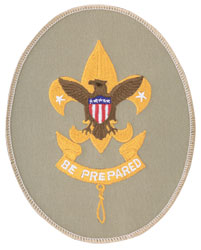
|
First Class Requirements:
|
1.
|
Demonstrate how to find directions during the day and at night without using a compass.
|
|
2.
|
Using a map and compass, complete an orienteering course that covers at least one mile and requires measuring the height and/or width of designated items (tree, tower, canyon, ditch, etc.).
|
|
3.
|
Since joining, have participated in 10 separate troop/patrol activities (other than troop/patrol meetings), three of which included camping overnight. Demonstrate the principles of Leave No Trace on these outings.
|
|
4a.
|
Help plan a patrol menu for one campout that includes at least one breakfast, one lunch, and one dinner, and that requires cooking at least two of the meals. Tell how the menu includes the foods from the food pyramid and meets nutritional needs.
|
|
4b.
|
Using the menu planned in requirement 4a, make a list showing the cost and food amounts needed to feed three or more boys and secure the ingredients.
|
|
4c.
|
Tell which pans, utensils, and other gear will be needed to cook and serve these meals.
|
|
4d.
|
Explain the procedures to follow in the safe handling and storage of fresh meats, dairy products, eggs, vegetables, and other perishable food products. Tell how to properly dispose of camp garbage, cans, plastic containers, and other rubbish.
|
|
4e.
|
On one campout, serve as your patrol's cook. Supervise your assistant(s) in using a stove or building a cooking fire. Prepare the breakfast, lunch, and dinner planned in require- ment 4a. Lead your patrol in saying grace at the meals and supervise cleanup.
|
|
5.
|
Visit and discuss with a selected individual approved by your leader (elected official, judge, attorney, civil servant, principal, teacher) your constitutional rights and obligations as a U.S. citizen.
|
|
6.
|
Identify or show evidence of at least 10 kinds of native plants found in your community.
|
|
7a.
|
Discuss when you should and should not use lashings. Then demonstrate tying the timber hitch and clove hitch and their use in square, shear, and diagonal lashings by joining two or more poles or staves together.
|
|
7b.
|
Use lashing to make a useful camp gadget.
|
|
8a.
|
Demonstrate tying the bowline knot and describe several ways it can be used.
|
|
8b.
|
Demonstrate bandages for a sprained ankle and for injuries on the head, the upper arm, and the collarbone.
|
|
8c.
|
Show how to transport by yourself, and with one other person, a person
- From a smoke-filled room
- With a sprained ankle, for at least 25 yards
|
|
8d.
|
Tell the five most common signals of a heart attack. Explain the steps (procedures) in cardiopulmonary resuscitation (CPR).
|
|
9a.
|
Tell what precautions must be taken for a safe trip afloat.
|
|
9b.
|
Successfully complete the BSA swimmer test.*
|
|
9c.
|
With a helper and a practice victim, show a line rescue both as tender and as rescuer. (The practice victim should be approximately 30 feet from shore in deep water.)
|
|
10.
|
Tell someone who is eligible to join Boy Scouts, or an inactive Boy Scout, about your troop's activities. Invite him to a troop outing, activity, service project, or meeting. Tell him how to join, or encourage the inactive Boy Scout to become active.
|
|
11.
|
Describe the three things you should avoid doing related to use of the Internet. Describe a cyberbully and how you should respond to one.
|
|
12.
|
Demonstrate Scout spirit by living the Scout Oath (Promise) and Scout Law in your everyday life. Discuss four specific examples (different from those used for Tenderfoot requirement 13 and Second Class requirement 11) of how you have lived the points of the Scout Law in your daily life.
|
|
13.
|
Participate in a Scoutmaster conference.
|
|
14.
|
Complete your board of review.
|
|
Star
|
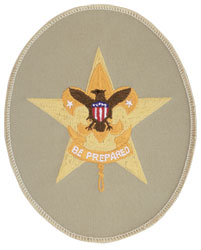
|
Star Requirements:
- Be active in your troop and patrol for at least four months as a First Class Scout.
- Demonstrate Scout spirit by living the Scout Oath (Promise) and Scout Law in your everyday life.
- Earn six merit badges, including any four from the required list for Eagle.
- While a First Class Scout, take part in service projects totaling at least six hours of work. These projects must be approved by your Scoutmaster.
- While a First Class Scout, serve actively for four months in one or more of the following positions of responsibility (or carry out a Scoutmaster-assigned leadership project to help the troop):
Scouts BSA troop. Patrol leader, assistant senior patrol leader, senior patrol leader, Venture patrol leader, troop guide, Order of the Arrow troop representative, den chief, scribe, librarian, historian, quartermaster, bugler, junior assistant Scoutmaster, chaplain aide, instructor, troop Webmaster, or Leave No Trace trainer.
Varsity Scout team. Captain, co-captain, program manager, squad leader, team secretary, Order of the Arrow troop representative, librarian, historian, quartermaster, chaplain aide, instructor, den chief, team Webmaster, or Leave No Trace trainer.
Venturing crew/ship. President, vice president, secretary, treasurer, den chief, quartermaster, historian, guide, boatswain, boatswain’s mate, yeoman, purser, storekeeper, crew/ship Webmaster, or Leave No Trace trainer.
- Take part in a Scoutmaster conference.
- Complete your board of review.
|
Life
|
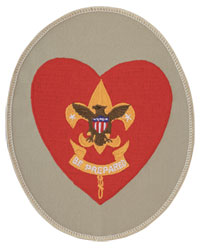
|
Life Requirements:
- Be active in your troop and patrol for at least six months as a Star Scout.
- Demonstrate Scout spirit by living the Scout Oath (Promise) and Scout Law in your everyday life.
- Earn five more merit badges (so that you have 11 in all), including any three more from the required list for Eagle. (See the Eagle Rank Requirements, number 3, for this list.) A Scout may choose any of the 15 required merit badges in the 12 categories to fulfill this requirement.
- While a Star Scout, take part in service projects totaling at least six hours of work. These projects must be approved by your Scoutmaster.
- While a Star Scout, serve actively for six months in one or more of the troop positions of responsibility listed in requirement 5 for Star Scout (or carry out a Scoutmaster-assigned leadership project to help the troop).
- While a Star Scout, use the EDGE method to teach a younger Scout the skills from ONE of the following six choices, so that he is prepared to pass those requirements to his unit leader’s satisfaction.
a. Second Class—7a and 7c (first aid)
b. Second Class—1a (outdoor skills)
c. Second Class—3c, 3d, 3e, and 3f (cooking/camping)
d. First Class—8a, 8b, 8c, and 8d (first aid)
e. First Class—1, 7a, and 7b (outdoor skills)
f. First Class—4a, 4b, and 4d (cooking/camping)
- Take part in a Scoutmaster conference.
- Complete your board of review.
|
Eagle
|
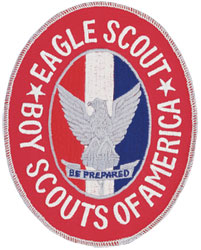
|
Eagle Requirements:
- Be active in your troop, team, crew, or ship for a period of at least six months after you have achieved the rank of Life Scout.
- Demonstrate that you live by the principles of the Scout Oath and Law in your daily life. List the names of individuals who know you personally and would be willing to provide a recommendation on your behalf, including parents/guardians, religious, educational, and employer references.
- Earn a total of 21 merit badges (10 more than you already have), including the following:
- First Aid
- Citizenship in the Community
- Citizenship in the Nation
- Citizenship in the World
- Communications
- Personal Fitness
- Emergency Preparedness OR Lifesaving
- Environmental Science
- Personal Management
- Swimming OR Hiking OR Cycling
- Camping
- Family Life
You must choose only one merit badge listed in items g and j. If you have earned more than one of the badges listed in items g and j, choose one and list the remaining badges to make your total of 21.
- While a Life Scout, serve actively for a period of six months in one or more of the following positions of responsibility:
The 2009 printing of the Boy Scout Handbook inadvertently included bugler as a position of responsibility under Eagle Scout requirement 4; is is not. The requirements presented here and in the 2011 Boy Scout Requirements book are correct and official.
- Scouts BSA troop. Patrol leader, assistant senior patrol leader, senior patrol leader, troop guide, Order of the Arrow troop representative, den chief, scribe, librarian, historian, quartermaster, junior assistant Scoutmaster, chaplain aide, instructor, Webmaster, or Leave No Trace Trainer.
- Varsity Scout team. Captain, co-captain, program manager, squad leader, team secretary, Order of the Arrow team representative, librarian, quartermaster, chaplain aide, instructor, den chief, Webmaster, or Leave No Trace Trainer.
- Venturing crew/ship. President, vice president, secretary, treasurer, boatswain, boatswain's mate, yeoman, purser, storekeeper, Webmaster, or Leave No Trace Trainer.
- While a Life Scout, plan, develop, and give leadership to others in a service project helpful to any religious institution, any school, or your community. (The project should benefit an organization other than Scouts BSA.) The project plan must be approved by the organization benefiting from the effort, your Scoutmaster and troop committee, and the council or district before you start. You must use the Eagle Scout Leadership Service Project Workbook, BSA publication No. 512-927
 , in meeting this requirement. , in meeting this requirement.
- Take part in a Scoutmaster conference.
- Successfully complete an Eagle Scout board of review.
|
Eagle Palms
|
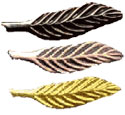
|
Eagle Palms Requirements:
After becoming an Eagle Scout, you may earn Palms by completing the following requirements:
- Be active in your troop and patrol for at least three months after becoming an Eagle Scout or after award of last Palm. (Eagle Palms must be earned in sequence, and the three-month tenure requirement must be observed for each Palm.)
- Demonstrate Scout spirit by living the Scout Oath (Promise) and Scout Law in your everyday life.
- Make a satisfactory effort to develop and demonstrate leadership ability.
- Earn five additional merit badges beyond those required for Eagle or last Palm. (Merit badges earned any time since becoming a Boy Scout may be used to meet this requirement.)
- Take part in a Scoutmaster conference.
- Complete a board of review.
You may wear only the proper combination of Palms for the number of merit badges you earned beyond the rank of Eagle. The Bronze Palm represents five merit badges, the Gold Palm 10, and the Silver Palm 15.
|











